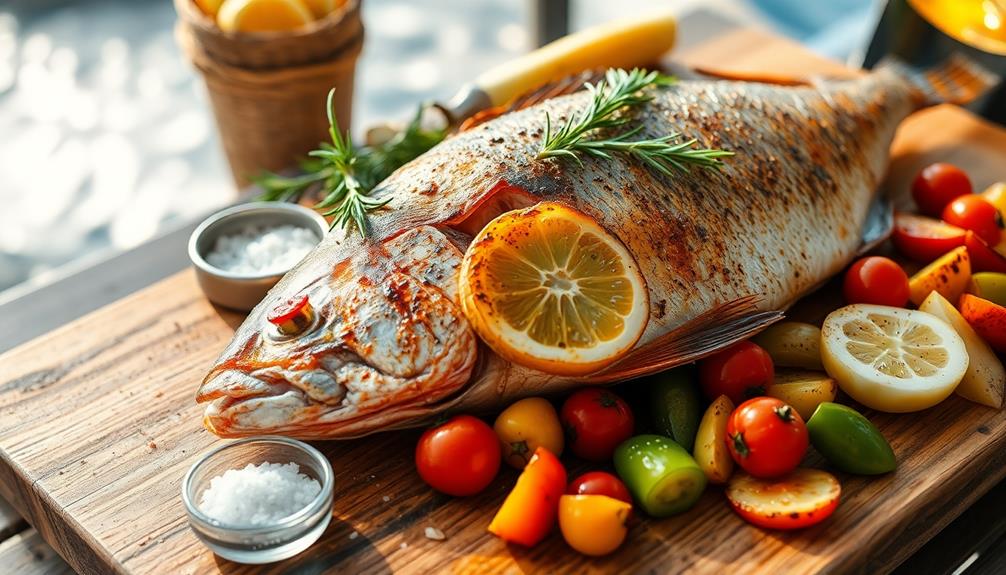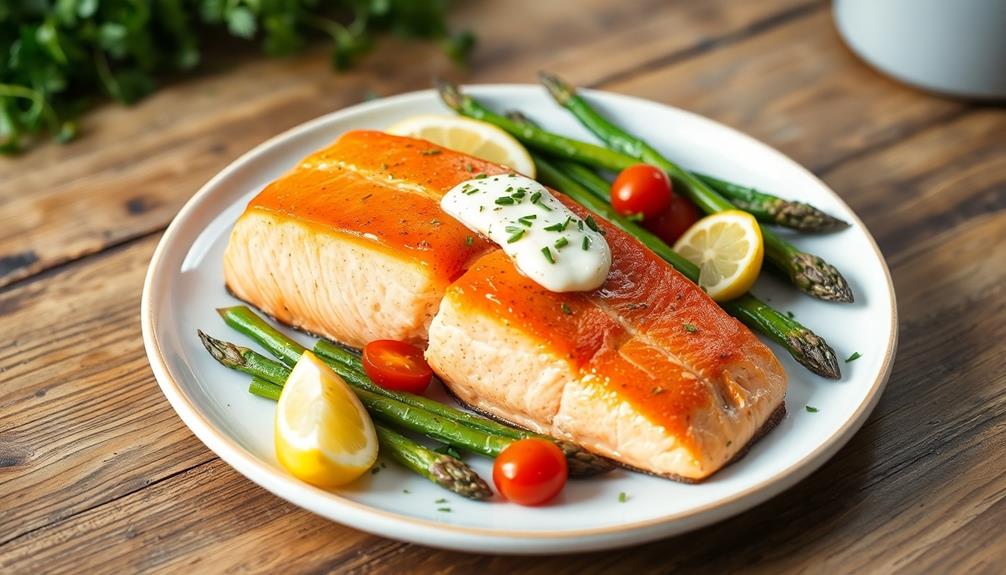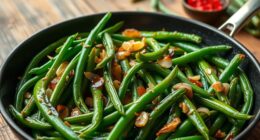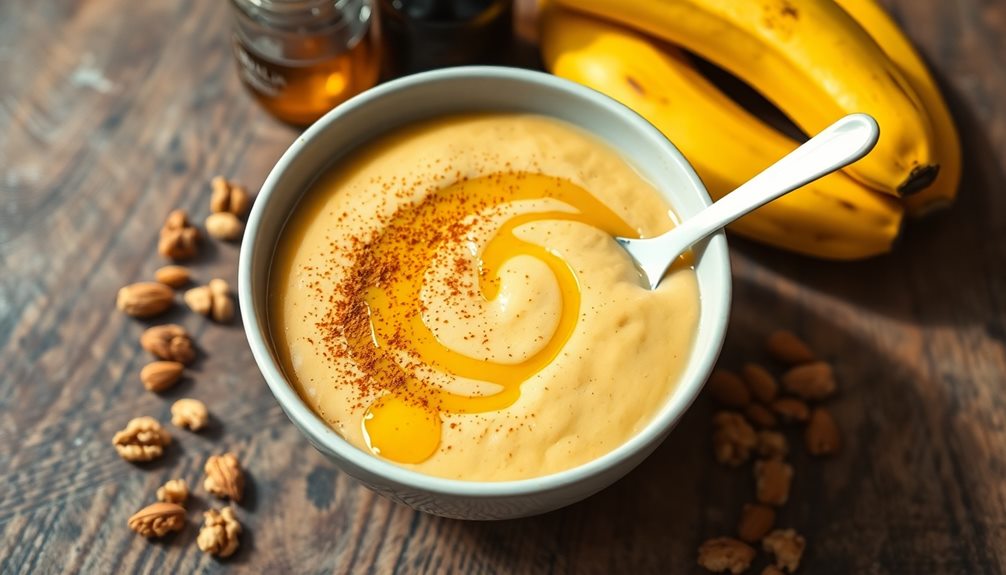Whole roasted local fish is a simple, delicious way to enjoy fresh seafood. You'll start by selecting a high-quality fish from your area. Clean and scale it, then season it inside and out with salt, pepper, and herbs. Stuff the cavity with aromatics like lemon slices and garlic. Roast the fish in a preheated oven at 425°F for about 10 minutes per inch of thickness. When it's done, the skin will be crispy and the meat tender. Serve your roasted fish with sides like roasted vegetables or a crisp salad. This method showcases the fish's natural flavors and promotes sustainability. Dive deeper to master this traditional cooking technique.
Key Takeaways
- Use the freshest local fish available for optimal flavor and texture in whole roasted fish.
- Season the fish inside and out with salt, pepper, and herbs before roasting at 425°F (218°C).
- Stuff the cavity with aromatics like lemon slices, garlic, and fresh herbs for enhanced flavor.
- Roast for approximately 10 minutes per inch of thickness, checking for doneness at the thickest part.
- Serve the whole roasted fish on a platter with garnishes, promoting sustainability and reducing food waste.
History
The tradition of whole roasted fish dates back centuries, with roots in coastal communities worldwide. You'll find that this cooking method has been passed down through generations, especially in Mediterranean and Asian cultures.
It's a simple yet effective way to prepare fish that's been cherished for its ability to preserve the natural flavors and moisture of the catch.
In ancient times, you'd often see whole fish roasted over open fires on beaches or in village gatherings. As cooking techniques evolved, people started using ovens and more advanced methods, but the basic principle remained the same.
The practice spread globally as trade routes expanded, introducing new spices and herbs to enhance the dish.
Today, you'll notice that whole roasted fish is still a popular choice in many restaurants and homes. It's seen as a way to honor the fish and reduce waste.
You're not just enjoying a meal when you eat whole roasted fish; you're participating in a culinary tradition that's stood the test of time.
Recipe
Whole roasted local fish is a simple yet elegant dish that showcases the natural flavors of fresh, locally-caught fish. This recipe allows the fish's delicate taste to shine through, complemented by aromatic herbs and a touch of citrus. By roasting the fish whole, you'll achieve a perfectly moist and tender result, with crispy skin that adds a delightful texture contrast.
This versatile recipe can be adapted to various types of fish, depending on what's available in your area. Whether you're using snapper, sea bass, trout, or any other whole fish, the cooking method remains the same. The key is to choose the freshest fish possible and to adjust cooking time based on the size of your fish.
- 1 whole fish (2-3 pounds), scaled and gutted
- 2 tablespoons olive oil
- 1 lemon, sliced
- 4 sprigs fresh thyme
- 4 sprigs fresh rosemary
- 4 cloves garlic, sliced
- Salt and freshly ground black pepper
- 1/4 cup dry white wine
Preheat your oven to 400°F (200°C). Rinse the fish and pat it dry with paper towels. Make 3-4 diagonal slashes on each side of the fish. Rub the fish inside and out with olive oil, then season generously with salt and pepper. Stuff the cavity with lemon slices, herbs, and garlic.
Place the fish in a roasting pan or on a baking sheet lined with parchment paper. Pour the white wine around the fish. Roast for 20-25 minutes, or until the flesh is opaque and flakes easily with a fork. The cooking time may vary depending on the size of your fish, so keep an eye on it to avoid overcooking.
For best results, let the fish rest for 5 minutes before serving. This allows the juices to redistribute, ensuring a moist and flavorful dish. If you're new to cooking whole fish, don't be intimidated by the bones – they're easy to remove once the fish is cooked. Simply run a knife along the spine and gently lift the fillet away from the bones.
Serve your whole roasted local fish with a side of roasted vegetables or a crisp salad for a complete and delicious meal.
Cooking Steps
You'll want to start by scaling and rinsing your fish thoroughly.
Next, season the fish inside and out with your favorite herbs and spices, then stuff the cavity with aromatics like lemon slices and fresh herbs.
Step 1. Scale and Rinse Fish
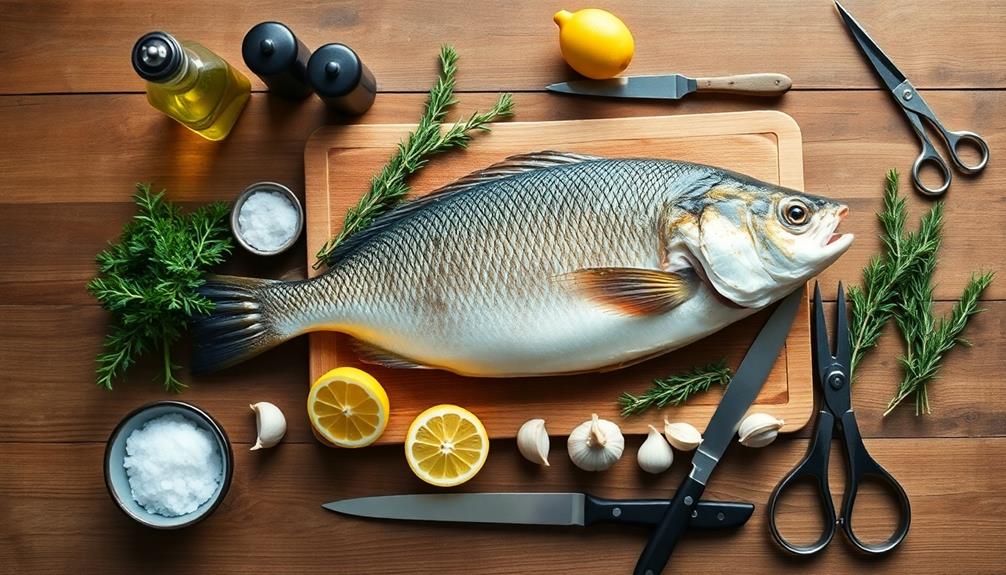
Before diving into the cooking process, it's essential to properly prepare your local fish. Start by scaling the fish, which removes the slippery outer layer. Hold the fish firmly by its tail and use a scaling tool or the back of a knife to scrape from tail to head. Work against the grain of the scales, applying gentle pressure. Don't forget to scale both sides and around the fins.
Once you've removed all the scales, it's time to rinse your fish. Place it under cool running water and gently wash away any loose scales or debris. Pay extra attention to the belly cavity, making sure it's clean inside and out. If you notice any remaining scales, use your fingers to remove them.
After rinsing, pat the fish dry with paper towels. This step is crucial for achieving crispy skin when roasting. Make sure to dry both the outside and inside of the fish thoroughly. Once the fish is dried, you can move on to seasoning and preparing it for roasting. A delicious crispy duck breast recipe often calls for a generous amount of salt and pepper to be rubbed onto the skin, along with any other desired seasonings. After this, the fish is ready to be cooked to perfection in the oven.
Now your local fish is ready for seasoning and cooking. This preparation process ensures that your whole roasted fish will be clean, appetizing, and free from any unwanted textures.
Step 2. Season Fish Inside and Out
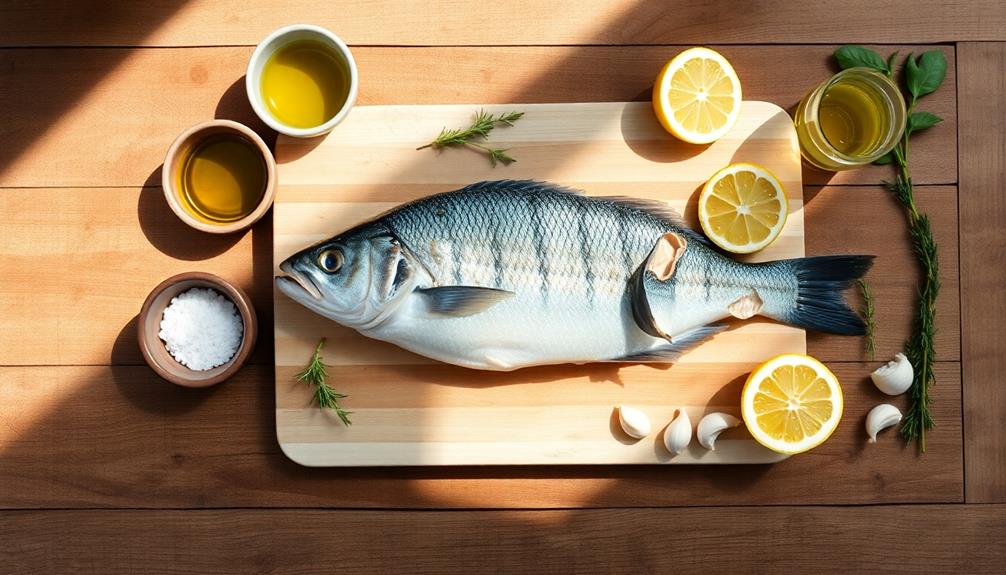
Now that your fish is clean and dry, how do you infuse it with flavor? It's time to season your fish inside and out.
Start by patting the fish dry with paper towels. This helps the seasoning stick better. Next, grab your favorite herbs and spices. You can use salt, pepper, garlic powder, and lemon zest for a classic taste. Or try something bolder like paprika, cumin, or dried herbs.
Sprinkle the seasoning mix all over the outside of the fish. Don't forget the fins and tail!
Then, gently lift the fish's gills and add some seasoning inside the cavity. This step is important because it flavors the fish from the inside out. You can also stuff the cavity with lemon slices, fresh herbs, or garlic cloves for extra taste.
Remember, you don't need to overdo it. A little seasoning goes a long way.
Once you're done, let the fish sit for about 15 minutes. This allows the flavors to soak in before cooking. Your fish is now ready for the next step in your roasting adventure!
Step 3. Stuff Cavity With Aromatics
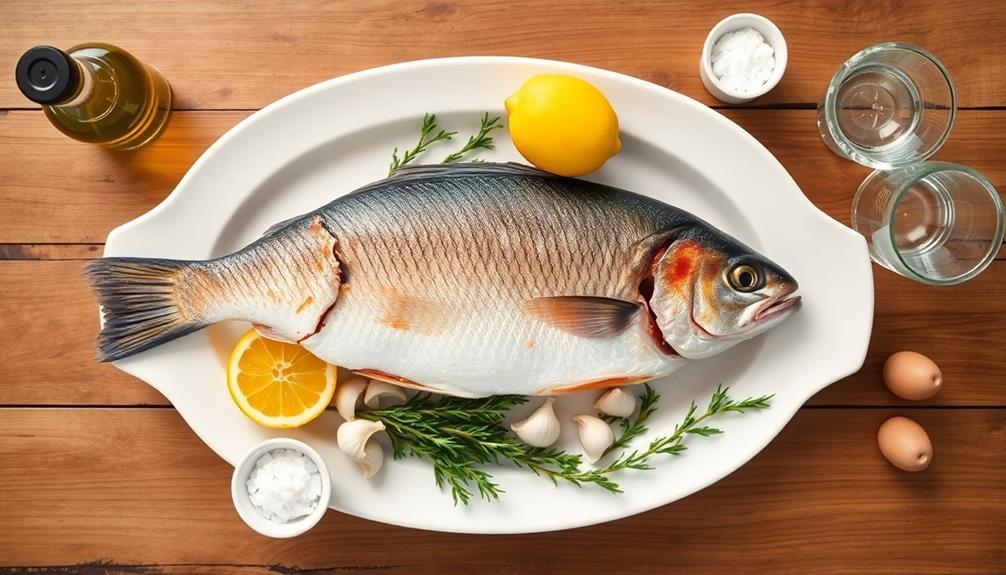
While seasoning the fish's exterior is crucial, stuffing its cavity with aromatics takes the flavor profile to new heights.
You'll want to choose ingredients that complement the fish's natural taste. Fresh herbs like parsley, dill, or thyme add a burst of freshness and aroma, and their health benefits can be a great addition to your meal. Additionally, consider incorporating some anti-inflammatory properties to enhance your dish further. Sliced lemons or limes are great for adding a zesty kick.
Don't forget to include garlic cloves and sliced onions for depth of flavor.
To stuff the cavity, first make sure it's clean and pat it dry. Then, gently place your chosen aromatics inside. Don't overstuff, as this can prevent even cooking. A good rule of thumb is to fill it about halfway.
You can also add a small pat of butter or a drizzle of olive oil to help distribute flavors. Once you've added the aromatics, secure the cavity with toothpicks or kitchen twine. This keeps everything in place during cooking.
Step 4. Roast in Preheated Oven

With your oven preheated to 425°F (218°C), it's time to roast your stuffed fish.
Place the fish on a baking sheet or in a roasting pan, making sure it's not crowded. If you're cooking more than one fish, leave some space between them. Drizzle a bit of olive oil over the fish to help it stay moist and get a nice, crispy skin.
Slide the pan into the middle rack of your oven. The cooking time will depend on the size of your fish. A good rule of thumb is to roast for about 10 minutes per inch of thickness. For example, if your fish is 2 inches thick at its thickest part, you'll want to roast it for about 20 minutes.
To check if your fish is done, gently insert a fork into the thickest part. If it flakes easily and is opaque all the way through, it's ready. If not, give it a few more minutes.
Don't overcook, as this can dry out the fish. Once done, carefully remove the pan from the oven and let the fish rest for a few minutes before serving.
Step 5. Serve and Garnish

Your beautifully roasted fish is ready to be served and garnished. Carefully transfer it to a large serving platter, making sure not to break the delicate skin. You'll want to present the whole fish for everyone to see before portioning it.
Now, it's time to add some final touches. Squeeze fresh lemon juice over the fish to brighten its flavors. Sprinkle chopped fresh herbs like parsley, dill, or cilantro over the top. These herbs will add color and a fresh taste. You can also add some lemon wedges around the fish for guests to use.
For extra flavor, drizzle a little olive oil over the fish. This will make it look shiny and appetizing. If you like, add some crispy capers or toasted pine nuts for texture.
Don't forget to bring a fish knife and spatula to the table for easy serving.
When you're ready to eat, gently separate the meat from the bones. Start at the head and work your way down to the tail. Enjoy your delicious, home-cooked whole fish!
Final Thoughts
Although cooking a whole fish might seem intimidating at first, it's actually a simple and rewarding process. You'll find that roasting a whole fish isn't only easier than you think, but it also results in a more flavorful and impressive dish. By following the steps we've outlined, you can confidently prepare a delicious local fish that will wow your family and friends.
Remember, the key to success is choosing fresh, high-quality fish and handling it with care. Don't be afraid to ask your fishmonger for advice on selection and preparation.
As you become more comfortable with the process, you can experiment with different seasonings and accompaniments to create your own signature dish. Cooking whole fish is also a great way to reduce food waste and appreciate the entire animal.
It's a sustainable and economical choice that connects you to traditional cooking methods. So, next time you're at the market, pick up a whole fish and give this method a try. You'll be surprised at how easy and satisfying it can be to create a stunning, restaurant-quality meal right in your own kitchen.
Frequently Asked Questions
What Are the Best Fish Varieties for Whole Roasting?
You'll find several fish varieties excellent for whole roasting. Consider trying snapper, sea bass, trout, or branzino. They're flavorful, easy to prepare, and hold up well to high heat. Don't forget about smaller fish like sardines or mackerel.
How Do I Know if the Fish Is Fresh Enough for Roasting?
You'll know the fish is fresh if it has clear, bright eyes, firm flesh, and a mild ocean scent. Check for red gills and shiny, tightly-adhered scales. Avoid fish with a strong fishy odor or slimy texture.
Can I Stuff the Fish Before Roasting It Whole?
Yes, you can stuff the fish before roasting it whole. It's a great way to add flavor. You'll want to use herbs, citrus, or aromatics. Just be careful not to overstuff, as it may affect cooking time.
What Side Dishes Pair Well With Whole Roasted Fish?
You'll love pairing roasted fish with light, fresh sides. Try roasted vegetables, lemon-herb rice, or a crisp salad. Don't forget crusty bread to soak up juices. For a Mediterranean twist, serve with tzatziki and olives.
How Do I Properly Debone a Whole Roasted Fish Before Serving?
To debone a roasted fish, you'll start by removing the head and tail. Then, use a fork to gently separate the flesh from the bones. Carefully lift the backbone out, and check for any remaining small bones.
